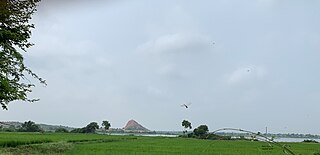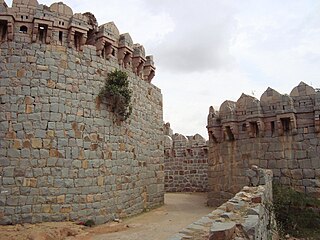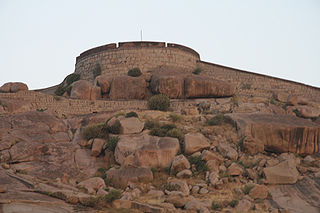The Raichur Doab is a Doab, in this case the triangular region of land in the southern Indian states of Telangana and Karnataka lying between the Krishna River and its tributary, the Tungabhadra River. The doab is named for the town of Raichur in the Raichur District. The Raichur Doab is considered to be very fertile because of the sediments carried by Krishna & Tungabhadra rivers. The doab includes Raichur district and Koppal district in Karnataka, and Gadwal district in Telangana. Some areas of Raichur doab also called as Nadigadda region became a part of Telangana during Andhra Pradesh Reorganisation Act in 2014.Those areas are Gadwal, Alampur and Maganoor. Gadwal is one of the 31 districts of Telangana State.

Raichur District is an administrative district in the Indian state of Karnataka. It is located in the northeast part of the state and is bounded by Yadgir district in the north, Bijapur and Bagalkot district in the northwest, Koppal district in the west, Bellary district in the south, Jogulamba Gadwal district of Telangana and Kurnool district of Andhra Pradesh in the east.

Chikmagalur, officially Chikkamagaluru is an administrative district in the Malnad subregion of Karnataka, India. Coffee was first cultivated in India in Chikmagalur. The hills of Chikmagalur are parts of the Western Ghauts and the source of Tunga and Bhadra rivers. Mullayanagiri, the highest peak in Karnataka is located in the district. The area is well known for the Sringeri Mutt that houses the Dakshina Peeta established by Adi Shankaracharya.
Manvi is a City in the Raichur district of the Indian state of Karnataka. It is the municipal headquarters of the Manvi taluk. Manvi Police Station stood fifth in the list of top 10 best police station across the country.
Akkalkot is a City and a municipal council in Solapur district in the Indian state of Maharashtra. It is situated 38 km southeast of Solapur and close to the border of Karnataka state.
'Economy of South India after independence in 1947 conformed to a socialist framework, with strict governmental control over private sector participation, foreign trade and foreign direct investment (FDI). Through 1960–1990, South Indian economies experienced mixed economic growth. In the 1960s, Kerala achieved above-average economic growth, while Andhra Pradesh's economy declined during this period. Similarly, Kerala experienced an economic decline in the 1970s while the economies of Tamil Nadu, Andhra Pradesh, and Karnataka consistently exceeded national average growth rates after 1970. Andhra Pradesh, Tamil Nadu and Karnataka were noted by some to be more reform-oriented in terms of economic policy when compared to other Indian states. Over the last decade South India has grown at 8% annually. Future economic growth will be shackled by a relatively low proportion of the active age population to the number of dependents.

North Karnataka is a geographical region in Deccan plateau from 300 to 730 metres elevation that constitutes the region of the Karnataka state in India and the region consists of 13 districts. It is drained by the Krishna River and its tributaries the Bhima, Ghataprabha, Malaprabha, and Tungabhadra. North Karnataka lies within the Deccan thorn scrub forests ecoregion, which extends north into eastern Maharashtra.
Raichur is a city and municipality in the district of Raichur in the Indian state of Karnataka. Raichur, located between Krishna and Tungabhadra rivers, is the headquarters of Raichur district. It is located 409 km from the state capital, Bangalore.
Bangarapet is a town in Kolar district in the state of Karnataka, India. Bangarapet is the headquarters of the taluk of Bangarapet. Bangarapet was originally called Bowringpet, named after an officer working in the Kolar Gold Fields. This town came into existence as the connecting point of traffic between the gold fields and Bangalore.
Kushtagi is a panchayat town in Koppal district in the Indian state of Karnataka. Kushtagi is a taluk center of Koppal district. This taluk has a population of 353,142 as per the 2021 census estimate. In this taluk, pomegranate fruits are popularly grown.There is a Durga devi temple in heart of the town. To its North lies Ilkal, Gajendragad to the West, Hospet to the South and Sindhanur to the East. Red and black soil can be found in this taluk. A big lake 4kms away from the city is the main source of drinking water is situated in west side and covering the area of more than 300 acres

Lingasugur is a municipal town in Raichur district in the Indian state of Karnataka. There are many Temples, hills and forts (Quila). The festivals of Muharram and Maha Shivaratri are important here. Mudgal in Lingasugur taluk has a very ancient fort. It has often been mentioned in the autobiography of Philip Meadows Taylor. Lingasugur, then known as Chavani was the site of a major British cantonment in the region.

Mudgal is a panchayat town in Lingsugur taluk, Raichur district in the Indian state of Karnataka. Mudgal is about 10 miles south-west of Lingsugur.

Ballari, formerly Bellary, is a major district in Karnataka. It is located at north-eastern part of Karnataka. This district belongs to Kalyana-Karnataka and Rayalaseema. This district was one of the biggest districts in Karnataka until the Vijayanagara district was carved out of Ballari district in 2021 officially.

The Indian State of Karnataka is located between 11°30' North and 18°30' North latitudes and between 74° East and 78°30' East longitude.It is situated on a tableland where the Western Ghats and Eastern Ghats converge into the complex, in the western part of the Deccan Peninsular region of India. The State is bounded by Maharashtra and Goa States in the north and northwest; by the Lakshadweep Sea in the west; by Kerala in the south-west and Tamil Nadu in the south and south-east, Andhra Pradesh in the south-east and east and Telangana in the north-east. Karnataka extends to about 850 km (530 mi) from north to south and about 450 km (280 mi) from east to west.

Karnataka is one of the highest economic growth states in India with an expected GSDP growth of 9.5% in the 2021–22 fiscal year. The total expected GSDP of Karnataka in 2022–2023 is about $240 billion. Karnataka recorded the highest growth rates in terms of GDP and per capita GDP in the last decade compared to other states. In 2008–09, the tertiary sector contributed the most to GSDP, followed by the secondary sector, and the primary sector.
Devadurga is a city in the sub-district (Taluka) within the Raichur district of the Indian state of Karnataka.
Hutti Gold Mines Limited (Kannada: is a company located in the state of Karnataka, India and engaged in the mining and production of gold. This was first established as Hyderabad Gold Mines in 1947. With the closing of Kolar Gold Fields in 2001, this is the one of the two companies in India which produce gold by mining and processing the gold ore, the other being Manmohan Minerals Industries Pvt. Ltd. Owned by the Government of Karnataka, HGML has two plants located in Hutti and Chitradurga. HGML mines gold from its main gold mine located in Hutti and other satellite mines.
Resources are classified as either biotic or abiotic on the basis of their origin. The Indian landmass contains a multitude of both types of resource and its economy, especially in rural areas, is heavily dependent on their consumption or export. Due to overconsumption, they are rapidly being depleted.
Gabbur also spelled as Gabburu is a village in the southern state of Karnataka, India. It is located in the Devadurga taluk of Raichur district in Karnataka.
Gurgunta also spelled as Guragunta is a village in the northern state of Karnataka, India. Gurgunta is famous for the ancient Amareshwara temple. It is located in the Lingasugur taluk of Raichur district in Karnataka. Karnataka National highway 150A passes through the village. This village is just 10 km away from Hutti Gold Mines, the unique primary gold producing company. This is also one of the hobli centre in Lingasugur taluka. This village consists of number of folds. most of the lands have been irrigated. Paddy is the major crop grown here. Remaining Non irrigated lands are grown by sun flower, cotton, toor, jawar etc. Major occupation is agriculture and small business. Huts and Mud roof houses are being replaced by RCC buildings. The famous Religious place Sri Gudagunti Amareshwara Temple is located near Gurgunta village. Before independence, Gurgunta was ruled by the Nayaka kings from 1636 to 1948. Around 16 Nayaka rulers have been ruled this state. In memory of this old fort and palace can be seen. This village consists of Grama Panchayat, Govt. P.U. College, High School, Primary School, RSK, Primary Health Centre, Veterinary dispensary, and hostel. Lord Venkateshwara Temple is located in the village. Navaratri Utsava (DASARA) is celebrated very nice. 9 days will be fully engaged in Bhajana and Purana functions. Moharam festival is also one of the famous festivals celebrated in the village. Gundlabandi Halla falls is small falls nearby 4 km. Tinthini Mouneshwara Temple is a religious and pilgrim place located near 20 km from Gurgunta. Though this village is not having bus stand and daily travelling passengers suffering a lot during summer and rainy season.








